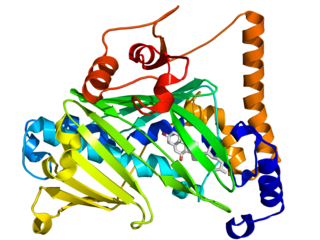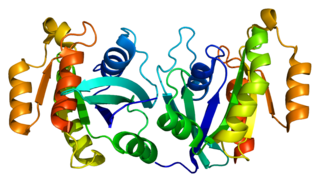Related Research Articles

The Golgi apparatus, also known as the Golgi complex, Golgi body, or simply the Golgi, is an organelle found in most eukaryotic cells. Part of the endomembrane system in the cytoplasm, it packages proteins into membrane-bound vesicles inside the cell before the vesicles are sent to their destination. It resides at the intersection of the secretory, lysosomal, and endocytic pathways. It is of particular importance in processing proteins for secretion, containing a set of glycosylation enzymes that attach various sugar monomers to proteins as the proteins move through the apparatus.

Exocytosis is a form of active transport and bulk transport in which a cell transports molecules out of the cell. As an active transport mechanism, exocytosis requires the use of energy to transport material. Exocytosis and its counterpart, endocytosis, are used by all cells because most chemical substances important to them are large polar molecules that cannot pass through the hydrophobic portion of the cell membrane by passive means. Exocytosis is the process by which a large amount of molecules are released; thus it is a form of bulk transport. Exocytosis occurs via secretory portals at the cell plasma membrane called porosomes. Porosomes are permanent cup-shaped lipoprotein structure at the cell plasma membrane, where secretory vesicles transiently dock and fuse to release intra-vesicular contents from the cell.
The Rab family of proteins is a member of the Ras superfamily of small G proteins. Approximately 70 types of Rabs have now been identified in humans. Rab proteins generally possess a GTPase fold, which consists of a six-stranded beta sheet which is flanked by five alpha helices. Rab GTPases regulate many steps of membrane trafficking, including vesicle formation, vesicle movement along actin and tubulin networks, and membrane fusion. These processes make up the route through which cell surface proteins are trafficked from the Golgi to the plasma membrane and are recycled. Surface protein recycling returns proteins to the surface whose function involves carrying another protein or substance inside the cell, such as the transferrin receptor, or serves as a means of regulating the number of a certain type of protein molecules on the surface.

General vesicular transport factor p115 is a protein that in humans is encoded by the USO1 gene.

Syntaxin-6 is a protein that in humans is encoded by the STX6 gene.

N-ethylmaleimide-sensitive factor Attachment Protein Alpha, also known as SNAP-α, is a SNAP protein that is involved in the intra-cellular trafficking and fusing of vesicles to target membranes in cells.

Exocyst complex component 4 is a protein that in humans is encoded by the EXOC4 gene.

Syntaxin-5 is a protein that in humans is encoded by the STX5 gene.

The oxysterol-binding protein (OSBP)-related proteins (ORPs) are a family of lipid transfer proteins (LTPs). Concretely, they constitute a family of sterol and phosphoinositide binding and transfer proteins in eukaryotes that are conserved from yeast to humans. They are lipid-binding proteins implicated in many cellular processes related with oxysterol, including signaling, vesicular trafficking, lipid metabolism, and nonvesicular sterol transport.

Exocyst complex component 7 is a protein that in humans is encoded by the EXOC7 gene. It was formerly known as Exo70.

Rab11 family-interacting protein 5 is a protein that in humans is encoded by the RAB11FIP5 gene.

Exocyst complex component 3 is a protein that in humans is encoded by the EXOC3 gene.

Exocyst complex component 5 is a protein that in humans is encoded by the EXOC5 gene.

Ras-related protein Rab-11B is a protein that in humans is encoded by the RAB11B gene. Rab11b is reported as most abundantly expressed in brain, heart and testes.

Autophagy-related protein 8 (Atg8) is a ubiquitin-like protein required for the formation of autophagosomal membranes. The transient conjugation of Atg8 to the autophagosomal membrane through a ubiquitin-like conjugation system is essential for autophagy in eukaryotes. Even though there are homologues in animals, this article mainly focuses on its role in lower eukaryotes such as Saccharomyces cerevisiae.
Membrane vesicle trafficking in eukaryotic animal cells involves movement of biochemical signal molecules from synthesis-and-packaging locations in the Golgi body to specific release locations on the inside of the plasma membrane of the secretory cell. It takes place in the form of Golgi membrane-bound micro-sized vesicles, termed membrane vesicles (MVs).
Rab GTPases are molecular switches that regulate membrane traffic. They are active in their GTP-bound form and inactive when bound to GDP. The GTPase YPT1, and its mammalian homologue Rab1, regulate membrane-tethering events on three different pathways: autophagy, ER-Golgi, and intra-Golgi traffic. In the yeast Saccharomyces cerevisiae, many of the ATG proteins needed for macroautophagy are shared with the biosynthetic cytoplasm to the vacuole-targeting (CVT) pathway that transports certain hydrolases into the vacuole. Both pathways require YPT1; however, only the macroautophagy pathway is conserved in higher eukaryotes. In the macroautophagy pathway, Rab1 mediates the recruitment of Atg1 to the PAS. Rab1 regulates macroautophagy by recruiting its effector, Atg1, to the PAS to tether Atg9 vesicles to each other or to other membranes.

Giantin or Golgin subfamily B member 1 is a protein that in humans is encoded by the GOLGB1 gene. Giantin is located at the cis-medial rims of the Golgi apparatus and is part of the Golgi matrix that is responsible for membrane trafficking in secretory pathway of proteins. This function is key for proper localisation of proteins at the plasma membrane and outside the cell which is important for cell function that is dependent on for example receptors and the extracellular matrix function. Recent animal model knockout studies of GOLGB1 in mice, rat, and zebrafish have shown that phenotypes are different between species ranging from mild to severe craniofacial defects in the rodent models to just minor size defects in zebrafish. However, in adult zebrafish a tumoral calcinosis-like phenotype was observed, and in humans such phenotype has been linked to defective glycosyltransferase function.

Exocyst complex component 6 is a protein that in humans is encoded by the EXOC6 gene.
Exomer is a heterotetrameric protein complex similar to COPI and other adaptins. It was first described in the yeast Saccharomyces cerevisiae. Exomer is a cargo adaptor important in transporting molecules from the Golgi apparatus toward the cell membrane. The vesicles it is found on are different from COPI vesicles in that they do not appear to have a "coat" or "scaffold" around them.
References
- ↑ Saha T, Dash C, Jayabalan R, et al. (2021). "Intercellular nanotubes mediate mitochondrial trafficking between cancer and immune cells". Nat. Nanotechnol. 17 (1): 98–106. doi:10.1038/s41565-021-01000-4. PMC 10071558 . PMID 34795441.
- 1 2 3 Hsu SC, TerBush D, Abraham M, Guo W (2004). "The exocyst complex in polarized exocytosis". Int Rev Cytol. International Review of Cytology. 233: 243–65. doi:10.1016/S0074-7696(04)33006-8. ISBN 978-0-12-364637-8. PMID 15037366.
- ↑ Bowser R, Müller H, Govindan B, Novick P (September 1992). "Sec8p and Sec15p are components of a plasma membrane-associated 19.5S particle that may function downstream of Sec4p to control exocytosis". J Cell Biol. 118 (5): 1041–56. doi:10.1083/jcb.118.5.1041. PMC 2289594 . PMID 1512289.
- ↑ TerBush DR, Novick P (July 1995). "Sec6, Sec8, and Sec15 are components of a multisubunit complex which localizes to small bud tips in Saccharomyces cerevisiae". J Cell Biol. 130 (2): 299–312. doi:10.1083/jcb.130.2.299. PMC 2199927 . PMID 7615633.
- ↑ TerBush DR, Maurice T, Roth D, Novick P (December 1996). "The Exocyst is a multiprotein complex required for exocytosis in Saccharomyces cerevisiae". EMBO J. 15 (23): 6483–94. doi:10.1002/j.1460-2075.1996.tb01039.x. PMC 452473 . PMID 8978675.